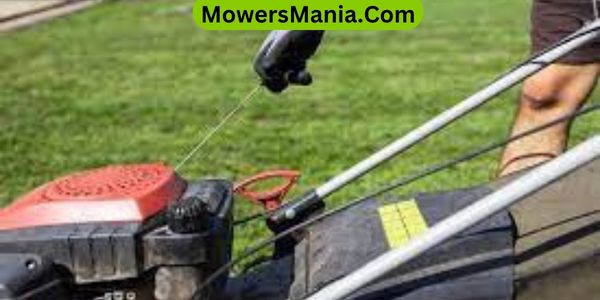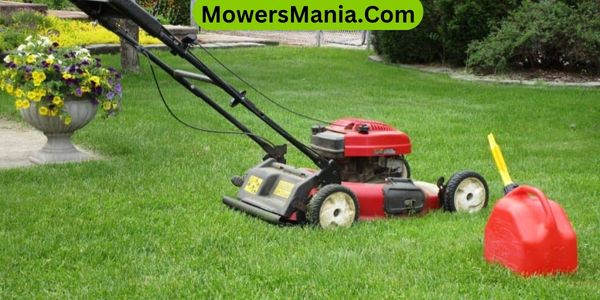So, you’re wondering how to adjust the choke on your lawn mower?
It’s a simple process that can make a big difference in your mower’s performance. By understanding the choke function and following a few simple steps, you can ensure your mower starts smoothly every time.

Let’s get started!
Understanding the Choke Function
To understand the choke function on your lawn mower, start by recognizing its role in regulating the air and fuel mixture for starting the engine.
The choke, usually located near the engine, restricts the airflow into the carburetor, enriching the fuel mixture.
When you start the lawn mower, the engine needs a richer fuel mixture to ignite and run smoothly. By pulling the choke, you reduce the air supply, allowing more fuel to enter the engine. This is crucial, especially when the engine is cold, as it requires a richer mixture to start.
As the engine warms up, you gradually push in the choke to increase the airflow and lean out the fuel mixture.
It’s important to remember that leaving the choke fully engaged after the engine has started can lead to an overly rich fuel mixture, causing the engine to sputter or stall.
Understanding how the choke affects the air and fuel mixture is essential for proper lawn mower operation and maintenance.
Identifying Choke Adjustment Mechanism
You can identify the choke adjustment mechanism by locating the lever or knob near the engine. This mechanism is typically situated on the side of the engine or near the air filter housing.
Once you’ve located the lever or knob, you can proceed with adjusting the choke to ensure optimal performance of your lawn mower.
Here are three common types of choke adjustment mechanisms you might encounter:
- Manual Lever: Some lawn mowers have a manual choke lever that can be adjusted by hand. This lever is often found near the engine and can be easily identified by its position and function.
- Choke Knob: Certain lawn mowers are equipped with a choke knob that can be turned to adjust the choke. The knob is usually located near the engine and can be rotated to achieve the desired choke setting.
- Automatic Choke: Modern lawn mowers may feature an automatic choke mechanism that adjusts the choke settings based on the engine’s temperature. This type of mechanism requires no manual adjustment and is designed to optimize the engine’s performance automatically.
Adjusting the Choke for Cold Starts

When starting your lawn mower in cold weather, adjust the choke to increase the fuel-to-air ratio for easier ignition. The choke restricts the airflow into the carburetor, enriching the fuel mixture for a cold start.
Follow these steps to adjust the choke for cold starts:
| Step | Instruction |
|---|---|
| 1 | Locate the choke lever or knob on the mower. |
| 2 | If your mower has a lever, move it to the “full” or “choke” position. If it has a knob, turn it to the “choke” position. |
| 3 | Prime the engine by pressing the primer bulb 3-5 times if your mower is equipped with one. |
| 4 | Pull the starter cord or turn the key to start the engine. Once the engine starts, gradually adjust the choke back to the “run” position as the engine warms up. |
Adjusting the Choke for Warm Starts
After starting the engine, gradually adjust the choke back to the ‘run’ position as the engine warms up. This will ensure that the engine receives the proper air and fuel mixture for efficient operation in warmer conditions.
Listen to the engine’s sound: As the engine warms up, listen for changes in the sound. When it begins to run smoothly without any sputtering or stalling, it’s a sign that the engine has warmed up sufficiently.
Gradually push the choke lever to the ‘run’ position: Once you notice the engine running smoothly, slowly push the choke lever to the ‘run’ position. Doing this too quickly may cause the engine to stall, so be patient and make the adjustment gradually.
Observe the engine’s performance: After adjusting the choke, observe the engine’s performance for a few minutes. If it continues to run smoothly without any issues, then the choke has been properly adjusted for the warmer conditions.
Testing the Choke Adjustment

To test the choke adjustment, start the engine and observe how it runs with the choke in the ‘run’ position. Once the engine is running, move the choke to the ‘choke’ or ‘start’ position and notice any changes in the engine’s behavior.
If the engine runs better with the choke in the ‘choke’ position, the adjustment may be too lean. Conversely, if the engine runs worse or dies with the choke in the ‘choke’ position, the adjustment may be too rich.
After observing the engine’s behavior, it’s time to make necessary adjustments to the choke. If the engine runs better with the choke in the ‘choke’ position, you may need to enrich the mixture by adjusting the choke to allow more fuel into the engine.
On the other hand, if the engine runs worse or dies with the choke in the ‘choke’ position, you may need to lean the mixture by adjusting the choke to allow less fuel into the engine.
It’s important to make small adjustments and test the engine again to find the optimal choke setting for smooth and efficient operation.
Frequently Asked Questions [FAQs]
How Often Should the Choke on a Lawn Mower Be Adjusted?
You should adjust the choke on a lawn mower whenever the engine needs a richer or leaner fuel mixture. Regularly check the choke adjustment based on the engine’s performance to ensure smooth operation.
Can I Use the Same Choke Adjustment for Different Types of Fuel?
Yes, you can use the same choke adjustment for different types of fuel in your lawn mower. Simply adjust the choke based on the specific fuel type you are using to ensure proper starting and operation.
What Are the Signs That Indicate the Choke Needs to Be Adjusted?
When the choke needs adjustment, your lawn mower may display symptoms like difficulty starting, stalling, or running too rich or too lean. These issues signal the need to adjust the choke for optimal performance.
Is It Possible to Damage the Lawn Mower Engine by Adjusting the Choke Incorrectly?
Adjusting the choke incorrectly can damage the lawn mower engine. It can cause the engine to run too rich or too lean, leading to poor performance or even engine stalling. Always follow the manufacturer’s guidelines for choke adjustment.
Are There Any Safety Precautions I Should Take When Adjusting the Choke on My Lawn Mower?
When adjusting the choke on your lawn mower, always ensure the engine is off and cool. Use caution when handling any engine components. Remember to refer to your mower’s manual for specific instructions on adjusting the choke.
Conclusion
Now that you’ve learned how to adjust the choke on your lawn mower, you can ensure that it starts smoothly in any weather condition.
Remember to always consult your mower’s manual for specific instructions and safety precautions before making any adjustments.
With the knowledge and skills you’ve gained, you can confidently maintain and troubleshoot your lawn mower for optimal performance.
Happy mowing!



